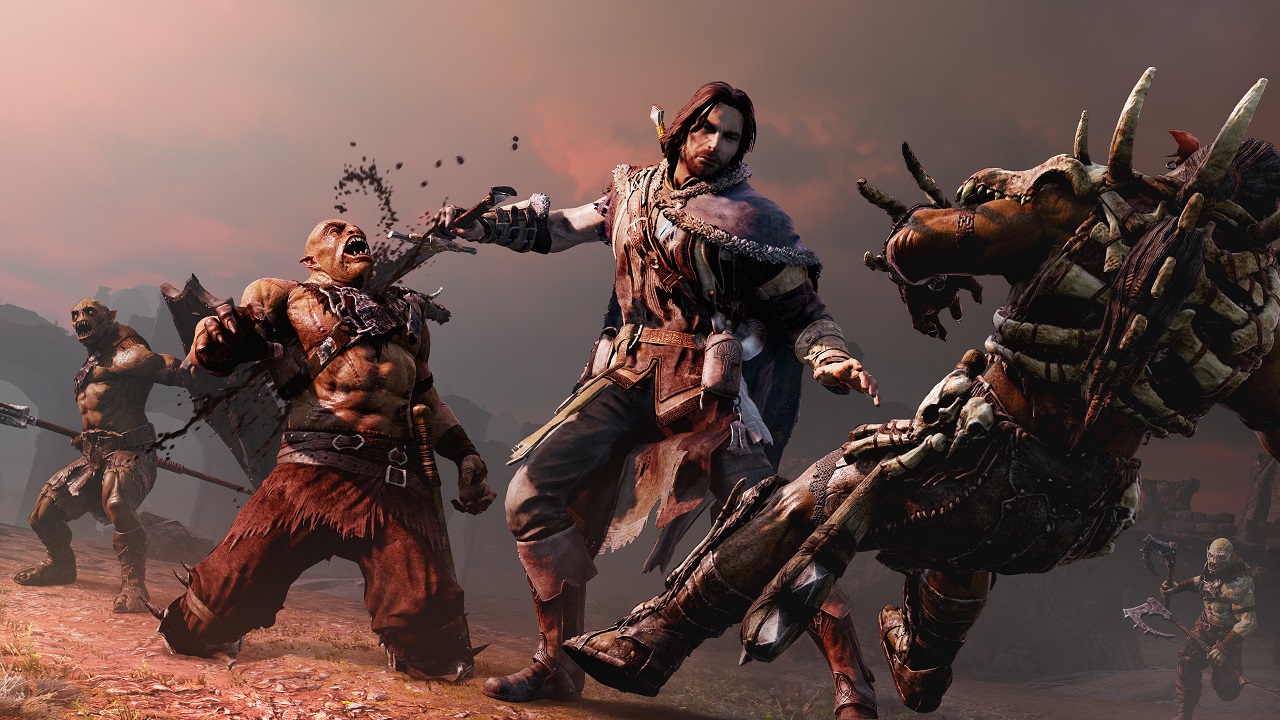Middle-Earth: Shadow of Mordor isn’t going to set the industry on fire. It won’t go down as an all-time classic; it cribs mercilessly from the mechanics of other games, its difficulty curve is far too steep in the opening hours due to a reluctance to hand you its basic mechanics, and the implementation of Tolkien’s universe often feels flimsy.
But after over 30 hours playing the game - during which time I completed the story, collected most of the artifacts and completed most of the challenges, and spent some time post-campaign messing around with the game’s Nemesis system (more on that later), I found myself having a much warmer opinion of developer Monolith’s latest title than I did in the first 10 or so hours. But first, a bit of background.
Shadow of Mordor is set between the events of The Hobbit and The Lord of the Rings. Bilbo has travelled To There And Back Again and now possesses the One Ring, while Sauron is still amassing his forces in Mordor. As time periods go, it’s one which Tolkien never explored in much detail in his books and is rife with potential. Players are cast in the shoes of the ranger Talion, who guards the Black Gate separating Sauron’s land of Mordor from the rest of Middle-Earth.
After Talion, his wife and son are murdered at the hands of Sauron’s forces during the game’s opening, the ranger finds himself resurrected by the ghost of Celebrimbor - the elf who forged the rings of power for Sauron many centuries ago, before being betrayed. Of course, having witnessed the murder of his wife and child has left Talion feeling rather aggrieved; so, with his newly-acquired supernatural powers, he sets out across Mordor on a quest for revenge.
The big question Monolith wanted to answer in Shadow of Mordor is: “What makes Sauron into the paranoid, twitching eye in The Lord of the Rings, instead of the towering badass you see in the film’s flashbacks?”
Have they managed to answer that question? Well, kind of - but mostly no. Shadow of Mordor does flesh out some of the lore and background of Tolkien’s fantasy setting, but it never does so in a way that feels satisfying, and the license ends up feeling like little more than window dressing. The Silmarillion is drawn upon to provide legitimacy to Shadow‘s premise, but characters are never given room to develop, while many of the events which transpire over the course of the 15-20 hours it takes to finish the campaign feel inconsequential and pass by with little impact.
As a result, the setting feels under-utilized. Appearances from well-known faces such as Gollum only reinforce the sense that the license has only been used to garner attention for a game which is, in many aspects, unremarkable.
Gameplay is best described as a mix of Assassin’s Creed and the Arkham games. You’re placed in an open world, split across two main maps, and carry out missions involving stealth, hunting wildlife and rescuing hostages. Along the way, there’s collectibles and side-challenges to complete, and a light stealth mechanic is introduced early but takes a back seat to the action. You can fast-travel between locations, make use of a vision mode almost identical to AC’s Eagle Vision or Batman’s Detective Vision, and interrogate enemies for information.
So far, so generic.
A couple of systems work to make the game enjoyable, though. While the difficulty feels unfairly punitive to start with (you’ll die a lot at the start of the game on anything other than the easiest settings), once you’ve levelled a few times and gained some abilities, combat starts to feel a lot more satisfying. If you’ve played any of Rocksteady’s Batman games, you’ll be in familiar territory - single-button attacks, a combo meter, and various abilities help you move from enemy to enemy. You can unlock a throwing knife which acts much like the batarang in Rocksteady’s games, leap over enemies and stun them, and incoming attacks can be automatically countered with a single button during a generous timing window. Violent execution moves take the place of takedowns, and by the end of the game you’ll be stringing together triple-digit combos with ease.
Derivative it may be, but combat is fast, fluid and eventually fun, if never requiring much thought. Shadow of Mordor is a game you’ll play to let off steam after a long day, instead of one you’ll play because you want a challenge.
The Nemesis system is the real star of the show, and where Monolith deserves the most praise. All Uruk (Tolkien’s name for Orcs, basically) exist within a hierarchy. At the bottom of the pile you have Grunts. Grunts do the bidding of Captains, who do the bidding of Warchiefs. A Warchief will usually have one or more Grunts or Captains as their personal bodyguards. Fell a Captain or Warchief in combat, and their absence creates a vacuum which another Uruk will attempt to fill or exploit. In addition, enemies often fight among themselves - carrying out assassinations in their attempt to climb the social ladder. As enemies gain experience they level up, growing in strength and influence. A Grunt can eventually work their way up to be a Warchief over time (and one of the game’s achievements actually requires you to assist them on that journey).
They also remember Talion. Die at their hands and not only will they become more powerful, but when you return to face them again, they’ll remark on how surprised they are - making a comment about how you were dispatched the last time you encountered them. They’ll also bear the scars of previous encounters, and gain a title and traits in addition to a unique name which sets them apart. An enemy who survived by fleeing combat might become known as The Coward, while an Uruk who has survived a fight after being seemingly killed might be awarded the title of The Unkillable.
Moreover, their previous experience shapes their personality. If an Uruk survived an encounter with a Caragor - a giant cat-thing - they could develop a pathological fear of the animals. You can exploit this by setting a caragor on them before engaging in combat, weakening morale and getting in some early damage to soften them up.
About a third of the way through, you gain the ability to Brand enemies. In battle, it’s used to gain information from your foes about other Uruks on the social ladder, or to turn them against their opponents. Brand a Captain or a Warchief though, and you get the ability to Dominate them, bringing them over to your side.
Once they’re fighting for you, you can send them on missions to ssassinate other Uruks, or become a Warchief’s bodyguard - giving you a helping hand when you come up against them. Branding allows you to play around with the Nemesis system and it’s worth doing to simply to test out the various possibilities on offer.
Shadow of Mordor never threatens to become strategic or tactical - the emphasis is very much on the action - but the Nemesis system opens up options that wouldn’t otherwise be there while giving generic foes more personality, and for that it’s very welcome. I wouldn’t be at all surprised if other developers are taking notes for their own game.
Despite all this fun, a bland world combines with awkward pacing and threadbare story to ensure that Shadow of Mordor never rises above being “good”. Mordor is supposed to be something of a ruined wasteland, admittedly, but the lack of landmarks at times makes the game’s map feel as though it’s little more than a series of identikit fields peppered with the odd ruined stronghold.
Enemies frequently spawn out of nowhere, meaning that what you thought was going to be a simple fight against a mere handful of enemies can frequently turn into bloody war sof attrition, resulting in a bodycount equivalent to a minor war. You can try to prevent this by taking enemies out stealthily, but the game’s auto-targeting for stealth kills sometimes either stubbornly refuses to lock on to a foe directly beneath you, or decides to focus on one other than who you want to target. And it’s all too easy to find that the game has spawned a nearby patrol after you’ve initiated combat, meaning they wander into the fray just as you think you’re done.
Visually, Shadow of Mordor is decent without ever impressing. Part of this is down to the bland world - a muted palette of greys, greens and browns can only provide so much eye candy, after all - but there are also clipping issues which see characters passing through scenery or each other, and low-res textures are abundant. The sound is more impressive - while the score is largely forgettable and the main characters all sound rather bored, the personality injected into each Uruk and the delivery of their lines never gets old, and there’s enough variety in the dialogue that it takes a while before you start noticing repetition.
Middle-Earth: Shadow of Mordor is a fun game, then, but also one which never reaches the heights it so clearly aspires to. The Nemesis system is a great innovation, the combat is fun if derivative, but the writing is lackluster and although Monolith has done a decent job of flavoring everything with Tolkien’s lore, it never comes close to the kind of attention to detail and passion seen in the likes of Turbine’s The Lord of the Rings MMO. The early sections of the game will also frustrate many, and side objectives and overall mission design lack variety and imagination. Shadow of Mordor is a solid effort, but not one destined to go down as a classic.







